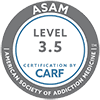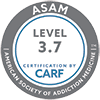A Moving Target
 What poses a challenge for one person doesn’t necessarily affect another individual, so trying to define “rock bottom” for people struggling with addiction is as easy as hitting a moving target. Certainly the stigmas and myths involving addiction contribute to a misunderstanding of how, why, or when someone should seek treatment for substance use disorder (SUD). Additionally, SUD is often a co-occurring condition, sometimes the result of emotional or mental health issues; or other compulsive behaviors, such as gambling, shopping, or sex addiction.
What poses a challenge for one person doesn’t necessarily affect another individual, so trying to define “rock bottom” for people struggling with addiction is as easy as hitting a moving target. Certainly the stigmas and myths involving addiction contribute to a misunderstanding of how, why, or when someone should seek treatment for substance use disorder (SUD). Additionally, SUD is often a co-occurring condition, sometimes the result of emotional or mental health issues; or other compulsive behaviors, such as gambling, shopping, or sex addiction.
There could be any number of reasons people consider substance abuse treatment, such as:
- Caused harm to someone emotionally, physically, or financially
- Compromised their intrinsic values by drinking or taking drugs excessively
- Created further mental, emotional, or physical harm to themselves
- Stayed in an unhealthy relationship because of a loss of self-worth and self-esteem
- Landed in legal or financial trouble as a result of addictive behavior
- Acknowledged that, for whatever reason, this particular way of life is no longer desirable
Some people go so far as to use the theory of “hitting rock bottom” as a shame tactic, which further threatens an individual’s ability to heal effectively.
In her books and conferences, noted research professor Dr. Brené Brown shares these thoughts: “I define shame as the intensely painful feeling or experience of believing that we are flawed and therefore unworthy of love and belonging—something we’ve experienced, done, or failed to do makes us unworthy of connection.”
On her website, she added: “I don’t believe shame is helpful or productive. In fact, I think shame is much more likely to be the source of destructive, hurtful behavior than the solution or cure. I think the fear of disconnection can make us dangerous.”
Brown’s research reveals that shame is a feeling: “I am bad.” However, guilt is a behavior: “I did something bad,” Brown said. She believes guilt can actually be a change agent to eliminate unwanted or destructive behavior. Someone may not believe the former in order to want treatment, but often the latter is a catalyst to actually moving forward with it.
Does It Have to Get Ugly?
Here again, because of the various reasons why people become addicted, it’s not always necessary to bottom out in order to need treatment. After all, if you break your leg, the ER doctor isn’t going to tell you to wait a few days to see if it gets worse before resetting it.
Often, not going to addiction counseling or a rehabilitation facility is preceded by a combination of deal making, comparison, and procrastination.
- “Well, I’m only drinking so much because I’m so stressed at work. When things even out, I’ll stop.”
- “I’m not a criminal, and I’m not in any financial trouble like some people, so I don’t really have a problem.”
- “My doctor said these drugs are necessary for my type of pain. When he tells me I don’t need them anymore, then I won’t use them.”
A person doesn’t have to fit the devastated addict stereotype to benefit from recovery. In an article for Psychology Today, clinical psychologist Bill Knaus explained that many people have the ability to make a “course correction”—especially if their motivation is supported by “less emotional stress and fewer severe problems.” He added: “If you realize that you need to change, then this message is clear enough. You don’t have to assume that you need to lose practically everything before you can bounce back.”
However, realizing the need for change is usually where a lot people have trouble.
It May Be Hard at First, But Change Is Possible
Over the past few years, scientists excitedly revealed new research about neuroplasticity. Simply put, this is the brain’s ability to eliminate old neural connections and create new ones. At one time, it was believed this function was limited after a certain age for almost all adults. Now studies demonstrate the results of not only positive brain changes, but also the many ways a person can continue to essentially reprogram the brain’s cognitive function.
The prefrontal cortex of the brain is responsible for stress response, self-regulation, delayed reward, and conscious aspects of choice, among other tasks. Someone in throes of SUD has altered executive function and compulsory control problems because of the effects of alcohol or drugs—which is why many experts in the medical community consider addiction a brain disease. The “habit” of addiction becomes hardwired into the mind and influences behaviors.
But there’s hope. For example, psychologist Mona Fishbane is one of many therapists who believes people are capable of living more consciously as to not be trapped by the usual patterns of their minds. However, it takes concerted effort to override the brain’s habit and change typical responses and actions. Through individualized addiction treatment, a person has access to numerous therapies that help them to not only break the patterns of addiction, but understand why they exist.
Ask Yourself a Few Key Questions
If you have even the slightest concern that substance abuse might be a problem for you or someone you love, stepping up now is the right thing to do.
The American Society of Addiction Medicine offers free, confidential, and anonymous online screening and assessment tools to help you consider your present circumstances. There’s one for alcohol, and another for drug use. Use what you learn to move one step closer to the person you really are.



